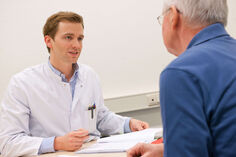Reflux Disease and Reflux Esophagitis
Causes
Reflux Disease is a condition caused by an increased reflux (flowing back) of the gastric (stomach) contents into the oesophagus, due to a failure of the valve-like mechanism at the lower oesophageal end.
Approximately 10 % of the population suffers from reflux disease and about 10% of these develop reflux esophagitis. Reflux oesophagitis results due to the constant reflux of acid from the stomach into the oesophagus. This leads to inflammation of and defects in the oesophgeal mucous membrane.
Symptoms
Heartburn i.e. burning behind the breast bone, acid regurgitation when bending or lying on the back, swallowing disorders, pain in the upper middle abdomen.
Diagnostic
Diagnosis of reflux disease is done with the help of an endoscope. The degree of abnormality in the mucous membrane is determined. If the mucous membrane seems suspicious, a tissue sample is taken in order to exclude the presence of "Barrett's esophagus" (serious abnormalities in the mucous membrane with cell transformation - metaplasia), and the development of atypia or even a tumor. In addition a 24 hour pH monitoring and a manometry is done.
Treatment
The initial therapy for reflux disease or reflux esophagitis consists of conservative measures such as having smaller meals, weight reduction, or giving-up smoking and alcohol, and avoiding drinks with high acidity. Sleeping with the head of the bed elevated can reduce the symptoms. In addition acid inhibiting medication such as proton pump inhibitors, which decrease the amount of acid produced, or an H2-Blocker (also results in a decreased acid production) can be administered.
In cases where conservative treatment fails and a persistence of symptoms is present or in cases of mucous membrane lesions with serious cell atypia (Barrett's esophagus), in cases of ulcers which won't heal, and in cases of scars causing a narrowing, surgery is indicated.
The purpose of surgery is always to prevent excessive reflux of the stomach contents into the esophagus. In specialized centers, if the patient's medical history permits it, this surgery is almost always done laparoscopically. The main procedure used is the fundoplication (according to Nissen and Rosetti). In this prodecure the top portion of the stomach (fundus) is wrapped around the back of the esophagus. The portion of the fundus which is now on the right side of the esophagus is sutured (sewn) to the portion on the left side to keep the wrap in place (the esophagus is in the middle with the fundus thus wrapped around it like a necktie) creating a musculature valve-effect, preventing stomach acid from flowing into the esophagus. Also the pathological width of the diaphragmatic opening through which the esophagus passes, is narrowed. Often a fixation of the stomach onto the diaphragm is performed so as to prevent it from sliding into the chest cavity.
If tissue samples of the mucous membrane, show serious cell atypia (metaplasia, dysplasia, Barrett's esophagus) or irreversible ulceration of the mucous membrane, the removal of the lower part of the esophagus has to be considered. This is due to distinct increased risk of malignancy in these cases. This surgery is generally performed by opening the upper part of the abdominal cavity with a vertical incision. The affected part of the esophagus is removed and the stomach is sutured (sewn) back onto the remaining esophagus. The opening of the chest cavity (thoracotomy) is usually not necessary. These cases are seldom and are closely discussed with the internist and pathologist to determine if if they necessarily come under the special indications are necessary.
Complications
The most important complications of insufficiently treated reflux oesophagitis are scar tissue causing narrowing of the esophagus, resulting in a limited passage of food or in the development of endobrachyesophagus (Barrett's Esophagus) with a distinct increased risk of malignancy (9-14%). After surgery the percentage of symptom free is 80-85%. A relapse occurs in 2-5% of the cases. A too tightly done fundoplication can result indifficulty in the passage of food with vomiting. In this case relief can be achieved with an endoscopical bougienage (dilatation) or the fundoplication must be redone.
Aftercare
Following successful surgery there will be a short period of cardiovascular monitoring in the recovery room with a rapid transfer to a normal ward. Often a feeding tube to the stomach is used to splint the esophagus, which is removed a day after the surgery. A rapid but gradual ingestion of food follows with liquid, mashed, and solid foods. As aftercare we then recommend regular endoscopic examinations to evaluate the mucous membrane. After successful surgery medications can be entirely discontinued.
